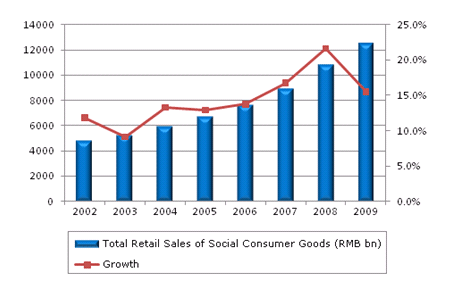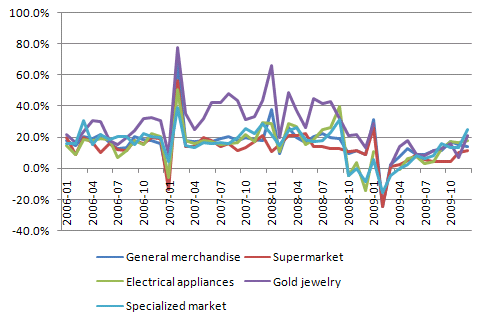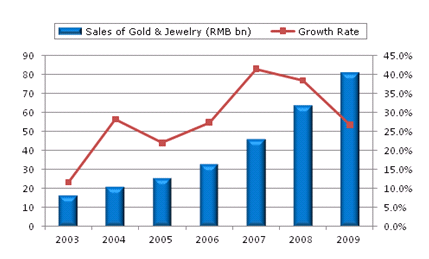|
China retail industry has taken on a trend of sustainable and rapid development in recent years, growing from RMB4.8 trillion in 2002 to RMB12.5 trillion in 2009. The upbeat industry has started to evolve from a single department store / neighborhood store model to a multi-business model, and a modern retail industry pattern dominated by specialized stores, supermarkets and department stores has already come into being.
Total Retail Sales & Growth of Social Consumer Goods, 2002-2009

Source: National Bureau of Statistics of China; ResearchInChina
The total retail sales of social consumer goods rose constantly in the first four months of 2010. The monthly growth rate of total social retail sales remained above 18% for three successive months and tends to increase month by month.
From the perspective of industry sectors, after the financial crisis, the general merchandise sector rebounded remarkably in 2009: the general merchandise was oriented to high-end and individualized consumption in first-tier cities, while regional general merchandise accelerated the expansion and hence caused a consumption boom in third-tier cities.
Supermarket Matures Gradually, Concentration Ratio Rises
Foreign-funded supermarket magnates are scrambling for bigger market shares in Mainland China, while most of the domestic-funded supermarkets are striving to dominate regional markets; the supermarkets in both third and fourth-tier cities develop faster than those in first-tier cities; the sales growth rates of the shopping malls in the villages and towns of prefecture-level cities and county-level cities/counties are 13-15 and 17-19 percentage points higher than that of first-tier cities. CR Vanguard, being the No.1 supermarket chain in China for years, will develop medium and high-end consumption markets in the future; Wuhan Zhongbai has maintained the most stable growth; Hualian Hypermarket opened new stores far beyond market expectations, and its business performance is likely to turn better in the coming one or two years.
Growth of Various Retail Sectors, 2006-2009

Source: WIND; ResearchInChina
Home Appliance Industry Steps Out of the Shadows
Suning Appliance Group has ranked the first of China Top 100 Chain Retailers with the sales of RMB117 billion. Gome Electrical Appliances, with sales of RMB106.8 billion and 1170 stores, is widening the income gap with Suning, and reduced the number of stores by 14%. IT chains and mobile phone chains delivered a mediocre performance: Hisap achieved revenue of RMB15.9 billion, down 11.2%; Dixintong increased its revenue by 4% to RMB6.8 billion, but the growth rate is lower than that of appliance chain enterprises such as Suning, Five-star, etc.
Jewelry Industry in Rapid Development
The market concentration ratio is relatively low since no brand can dominate the market. Renowned global brands not only occupy the high-end market, but also distribute channels in low and medium-end markets. The total sales of gold and jewelry of China in 2009 broke through RMB80 billion, only second to the USA and Japan; promisingly, Chinese jewelry market will continue to keep the annual growth rate of 15% in the coming years, since the upgrading of consumption structure and accelerated urbanization resulted from the improved consumption capacity of Chinese residents have increased the demand for jewelry, sharply enhanced the purchasing power of female consumers, and raised the wedding market.
Sales & Growth of Gold, Silver and Jewelry, 2003-2009

Source: WIND; ResearchInChina
Compared with general markets, specialized wholesale markets have maintained rapid growth in both quantity and trading volume in recent years. The development of Chinese commodity transaction markets has given priority to specialized markets with general markets as supplement. Of which, Small Commodities City and Haining Leather City, two specialized wholesale markets, possess certain edges within the industry.
For more information, please visit http://www.researchinchina.com/Htmls/Report/2010/5901.html |